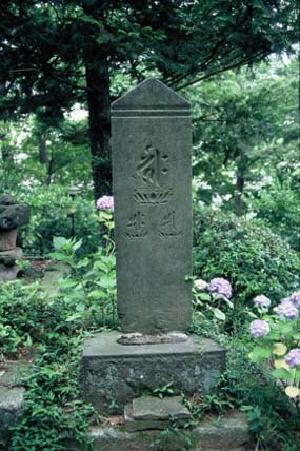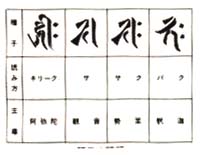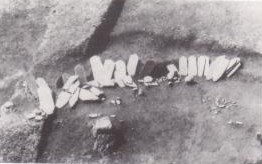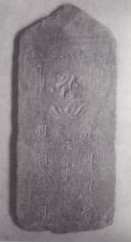Update date: June 27, 2017

Myokaku-ji temple monument (City-designated cultural property)

Name of each part of the tablet
History of stone tablets
Stone tablet It was built between the Kamakura and Azuchi-Momoyama periods (13th to 16th centuries). Memorial tower And the dead Memorial They were built all over the country in hopes of bringing comfort to future generations.
Due to the difference in the stone materials used in each region, some have different shapes, but most have the following shape. The overall shape is a slab, and the top part is made into a triangular mountain shape. Nijo Line The main part is divided into rectangular sections, with cuts and slits to distinguish it from the main part. Tathagata or Bodhisattva of Sanskrit letters or images seed , canopy・Lotus pedestal・Vases, etc. Pattern , Era inscription The names of donors are inscribed.
It is believed that the stone tablet originated in the central and northern part of Musashi Province, the home of the Kanto samurai. Karoku There is a stone tablet dating back to 1227, and it is believed that they gradually spread from this region to the surrounding areas, and eventually became distributed throughout the country. Looking at the whole country, they are found to be most abundant in the Kanto region, and this is the Chichibu region of Saitama Prefecture. Chlorite schist This is because they used blue rocks that are easy to process. Musashi-style stone monument The custom of erecting stone tablets, which began in the Kamakura period, spread mainly in Musashi Province. Popular However, they disappeared at the end of the Middle Ages. By the Edo period, they had completely disappeared, and the construction of gravestones eventually became the norm. For these reasons, itahi can be said to be a representative stone structure of the Middle Ages.
Monument in Inagi City
Currently, 268 stone tablets have been identified in the city. Made of chlorite schist Not only recently Made of Ina stone One stone tablet was identified. Most are small, measuring around 50 to 60 centimetres in height. By area, Omaru district has the most with 102, followed by Yanokuchi district with 44, Hirao district with 43, Sakahama district with 30, and Momomura district with 28. Higashinagumanuma (5) and Oshitate (7) districts have smaller numbers (9 unknown). They are distributed near old settlements and old roads, in the border areas between the hills and plains, and along the Tama River. Floodplain However, because of their size, stone monuments are movable, and it is necessary to take into consideration the possibility of them being washed away by flooding of the Tama River or being moved secondary to other locations.
The oldest monument in the city is Right response The most recent one was built in 1289. Astronomy It was erected in 1536. The construction of stone tablets continued for about 250 years during this time (from the late Kamakura to the late Muromachi periods), with the period from the 1310s to the 1390s being the most prosperous.
Characteristic monument
Below we will introduce some of the distinctive stone monuments.
The stone tablet at Myokaku-ji Temple in Yanoguchi (pictured above) is 112 centimetres above ground, making it the largest stone tablet in the city, as well as being well-formed and well-preserved. seed of Amida Triad " Reverse Repair Michihide Zen Gate The name of the donor is engraved. Kyotoku 3rd year (1454) Era inscription The above is clearly engraved on the wall. The only example in the city is the following: Light Mantra Represents Sanskrit letters is written over four lines.
There are few similar cases in the southern Kanto region. Thirteen Buddhas Monument Two stone tablets have been discovered. seed This represents Five Buddhas , Seven Bodhisattvas , King I It became popular as a folk belief from the Muromachi period onwards, where people worshipped the thirteen Buddhas as a group. It is also distinctive in that the arrangement of the thirteen Buddhas is unique and different from the usual one.
The stone tablet excavated from the Nyujozuka in Hirao reads: Gold mud It is a rare stone monument that remains, and the mound is where the deity was buried. Naganobu Seal That Esoteric Buddhism The names of the monks are inscribed on it, making it a valuable historical document that shows the reality of their faith.
Other notable monuments include: Shinto stone monument or Jishu sect System Amigo stone monument " Namu Amida Butsu " Six-character name Another unique excavation example is the discovery of three groups of stone tablets (78 in total) on the slopes of the Omaru ruins, which are thought to have been collected from other locations and rearranged secondarily.

kind of glyph

Group of stone tablets excavated from the Daimaru site

Thirteen Buddha tablet monument (Inagi City storehouse)












